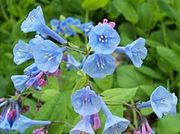bluffviewnursery.org
ORDER NOW FOR ALL YOUR WINTER AND SPRING PLANTING NEEDS,WE ACCEPT PAYPAL BUT IF YOU DONT HAVE PAYPAL GIVE US A CALL OR TEXT US AT 931-808-4377 WE ACCEPT VISA MASTER CARD AMERICAN EXPRESS AND DISCOVERGROWERS OF TOP QUALITY AND TRUE TO NAME WILDFLOWERS AND GROUND COVERS
100 virginia blue bells root systems,Mertensia virginica
Product Description
virginia bluebells,hi you are buying 100 virginia bluebells root systems,The Virginia Bluebells, Mertensia virginica, has many different common names,including Virginia Cowslip",Lungwort, Oysterleaf and Roanoke Bells.virginia bluebells is a species of plant belonging to the family Boraginaceae. This virginia bluebell ranges in height from 12~24 inches. The most distinguishing feature of the plant is the noticeable bell-shaped flower, which is usually blue or violet in color. Description
These herbaceous plants grow best in moist, rich, and loamy soils. virginia bluebells can be found in upland forests, floodplain forests, wetlands and bluffs. These plants prefer slight to full shade. The single stem begins curled in shape and extends as it grows into an elegant arch to hold to blossom cluster. The leaves are alternately located around a thin, smooth stem attached by petioles near the base, but as you move upward towards the flower cluster, the leaves are simply attached straight to the stem. The leaves are oval-shaped with pinnately-simple venation. The blossom cluster is located above the simple leaves. Flowering occurs in spring from March to May.
Each blossom consists of five petals fused into a tubular shape. The bud begins with a pinkish shade that transforms into a blue-violet color as it matures.[1] White blossoms occur rarely,[1] and soil pH can affect flower color.[1] The flower is approximately one inch deep with five stamens surrounding one central pistil; however, the reproductive organs are spaced too far from one another for self-fertilization. The flower can be pollinated by bumblebees, but due to its funnel shape, bumblebees must hover, making the bumblebee a rare pollinator. Butterflies are the most common pollinators, because they can easily perch on the edges and still enjoy the nectar. Each plant produces four wrinkled nuts containing seeds. The flowers die rather quickly, and the plants are usually dormant by early June or July.
[edit] Cultivation Plants should be spaced nine to twelve inches apart in acidic to mildly alkaline soils. They are hardy to a minimum winter temperature near -24° Fahrenheit. Bareroot plants can be planted at any time during dormancy, and are usually available from nurseries in the fall and spring. Since the plants make growth early in the spring, they should be planted as early as possible. Potted plants can be purchased from the nursery and planted at any time, although, of course, in the summer and fall the pots will contain only the dormant root and no growth will be visible above the soil. Virginia bluebells can also be grown in an unheated greenhouse. Seeds can be stratified for sowing indoors and then planted outdoors as young plants. Virginia bluebells are not suitable for growing indoors. Although Virginia bluebells can be propagated by seed, plants can also be divided in the early spring by gently pulling apart the root stock to transplant the divided plants.
Because these are ephemeral plants, meaning that they grow and flower quickly and go dormant for the rest of the growing season, it is also suggested that one should plant these flowers close to flowers that bloom later in the year. This way, your garden will have color in that area for more of the summer season
Each blossom consists of five petals fused into a tubular shape. The bud begins with a pinkish shade that transforms into a blue-violet color as it matures.[1] White blossoms occur rarely,[1] and soil pH can affect flower color.[1] The flower is approximately one inch deep with five stamens surrounding one central pistil; however, the reproductive organs are spaced too far from one another for self-fertilization. The flower can be pollinated by bumblebees, but due to its funnel shape, bumblebees must hover, making the bumblebee a rare pollinator. Butterflies are the most common pollinators, because they can easily perch on the edges and still enjoy the nectar. Each plant produces four wrinkled nuts containing seeds. The flowers die rather quickly, and the plants are usually dormant by early June or July.
[edit] Cultivation Plants should be spaced nine to twelve inches apart in acidic to mildly alkaline soils. They are hardy to a minimum winter temperature near -24° Fahrenheit. Bareroot plants can be planted at any time during dormancy, and are usually available from nurseries in the fall and spring. Since the plants make growth early in the spring, they should be planted as early as possible. Potted plants can be purchased from the nursery and planted at any time, although, of course, in the summer and fall the pots will contain only the dormant root and no growth will be visible above the soil. Virginia bluebells can also be grown in an unheated greenhouse. Seeds can be stratified for sowing indoors and then planted outdoors as young plants. Virginia bluebells are not suitable for growing indoors. Although Virginia bluebells can be propagated by seed, plants can also be divided in the early spring by gently pulling apart the root stock to transplant the divided plants.
Because these are ephemeral plants, meaning that they grow and flower quickly and go dormant for the rest of the growing season, it is also suggested that one should plant these flowers close to flowers that bloom later in the year. This way, your garden will have color in that area for more of the summer season
we accept paypal on our website but if you dont have paypal you can call or text us at 931-808-4377 and place your order over the phone we accept visa master card american express and discover cards 

